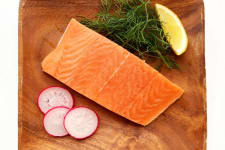Steamed fish doesn’t have to be a strictly lean, watery affair. When you use steam to cook a fat-rich species like wild-caught sablefish, the result is always a decadent, moist, and flaky fillet that’s quick to make and doesn’t require any additional fats. Nicknamed butterfish for its buttery qualities, sablefish lives up to its deliciously suggestive nickname even when you steam it.
While many of us are accustomed to broiling or pan-searing sablefish — it’s a fish that’s particularly forgiving to high-heat methods of cooking — knowing how to steam sablefish simply opens up more culinary possibilities for this versatile fillet. Steamed sablefish is a light but satisfying protein when you want something a little brothy to enjoy over a bowl of rice, or to roll into rice paper with a little dipping sauce on the side.
To steam the sablefish, we suggest steaming it en papillote — in a parcel of parchment paper. This method allows you to add liquid seasonings, aromatic components, and tender veggies that will have enough time to steam alongside a delicate protein like fish.
Steaming Sablefish in a Parchment Packet
Preheat your oven to 400 degrees.
Meanwhile, eyeball how much parchment you think you’ll need to create an envelope or packet that can hold your fillets of sablefish with some wiggle room for steam to circulate, laying it out flat or nestling it in a shallow plate so that you have a small basin to fill with liquid ingredients without them spilling out. You can use multiple packets to create individual servings, or assemble a larger one to cook a couple together.
In a separate bowl, mix up any combo of liquids and dry components that taste good to you: This is going to become a brothy sauce to enjoy with the fish. You could use a mix of soy, sugar and ginger. Or use a splash of coconut milk, a touch of curry paste, and cilantro with some kaffir lime leaves. Taste for seasoning — whatever you put on the plate should be sippable and palatable, though the flavor will develop a bit as sablefish releases its naturally occurring oils into the mix. Add a splash of water to dilute if it seems too intense; or, add something salty if it’s not strong enough. If you like, you can add a flavorful oil like sesame oil, chili oil, or a decent extra virgin olive oil to round out your recipe.
After you’ve done some tasting and adjusting, arrange the sablefish fillets skin-side down onto a layer of parchment, ideally with at least half an inch between fillets if you’re steaming more than one. Pour your liquid mixture over the fish, then seal up the edges of the packet well so that it’s as airtight as you can get it.
Transfer the packets to a baking sheet, then put them in the oven. The baking sheet makes it easier to pull the fish in and out of the oven, and will also capture any spills in case your packets aren’t totally sealed up.
Sablefish will need about 15 to 20 minutes to steam, depending on the thickness of the fillets. You can press down onto the packets to get an idea of how flaky the fish has become. If you can’t quite tell, you can always open up the packet to check on the flakiness or use a thermometer to check its internal temperature; it should register at 135 degrees when cooked to tender perfection. Sablefish will be completely done when it looks just opaque in the center and when the skin slips away from the flesh without much coaxing.
If the fillets aren’t quite cooked enough, reseal the packet if it’s been opened and allow the fish to steam for a few more minutes.
Serve immediately straight from the packets or on a serving platter, taking care when opening up the parchment, as it will release hot, delicious steam as soon as it’s opened.
Steamed Sablefish Inspiration
This recipe from Epicurious leans Mediterranean with the addition of herbs, olives, and good olive oil. It’s a great template for any time you’re looking to make full meals in a single packet, as it steams the sablefish with thin slices of young Yukon gold potatoes.
Bon Appetit’s recipe for sablefish takes a slightly different approach to steaming, creating an aromatic liquid that steams the fish from below without a packet; some of this liquid is reserved as a sauce for serving.






